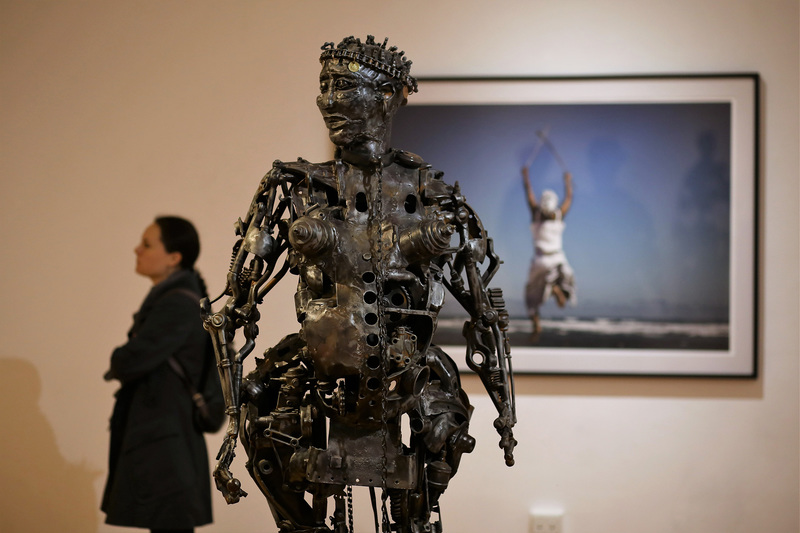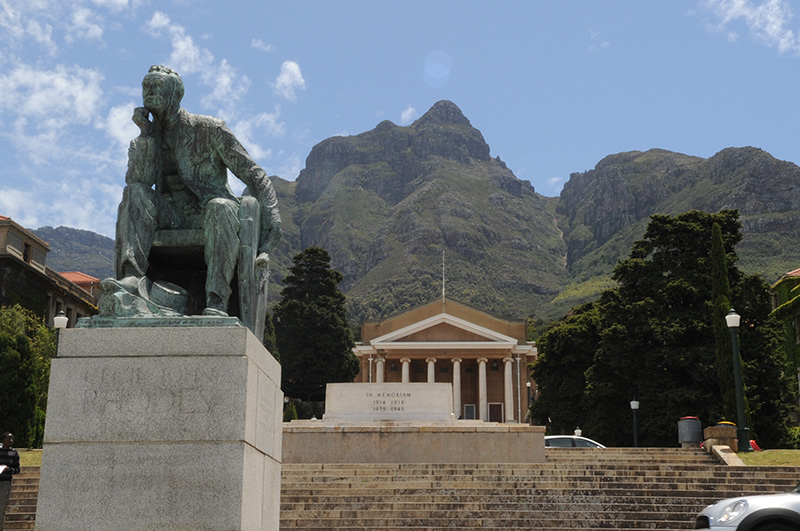Tackling an ‘uneasy campus culture’
11 January 2019 | Story Carla Lever. Read time 6 min.
The crown jewel in University of Cape Town’s (UCT’s) symmetrically pleasing main campus is its hall. The campus lies in linear regularity against the iconic backdrop of Devil’s Peak, part of the spectacular mountain range that circles the city. The triangular parapet of the hall reaches for the peak even as its steps cascade down towards the busy streets of Rondebosch, the suburb below.
With UCT ranking as the top university on the continent, this stock image has come to symbolise more than just one campus, but African excellence itself.
The physical view of the campus changed forever in 2015, with the removal of the brooding statue of British colonialist Cecil John Rhodes at the foot of the staircase. Now, in 2019, the scene will change symbolically too. Jameson Memorial Hall stands, but its name falls: going forward, it will be known as the Sarah Baartman Hall. Baartman, a Khoi woman sold into slavery and eventually exhibited as a curiosity in England in the late 18th Century, has long been a powerful symbolic figure in contemporary South Africa. This remarkable UCT turnabout moves the commemoration narrative. As the official UCT announcement notes,
it is fitting that Baartman, a victim of colonial inhumanity, should replace a perpetrator of colonial crimes.
The announcement was made by incoming Vice-Chancellor Mamokgethi Phakeng in her December 2018 robing ceremony. It had, in fact, been in the works from 2015’s Fallism protest movement. At the time then-Vice-Chancellor Max Price created a task team and invited renaming suggestions. At that point, Jameson Hall, named after Rhodes’ political ally Leander Starr Jameson, was temporarily given the generic placeholder of Memorial Hall. This was a gesture to the centrality of institutional memory, but strategically vague as to what kind of memory that should be.
Now, after extensive consultation both within the university community and with Khoi community representatives, the decision has been made. It’s one the university itself is naming “potent” and “historic.” But how radical is it?
It’s undoubtedly encouraging - more than that, exciting - to see UCT nail their colours to the mast in what feels like an embrace of structural transformation, not to mention a powerful signal of a commitment to a decolonial agenda.
Yet I have reservations.
A much deeper problem
Let us be frank: Sarah Baartman Hall is not named as an abstract decolonial gesture. It’s not a simple symbolic reference to a closed chapter of history, chosen at random from hundreds of alumni submissions. It is so named explicitly because of the direct trauma that people of colour experienced from the ongoing campus exhibition of an underclad statue of Baartman from 2000 to 2018 in the Science and Technology section of the main library. The statue stood not 200 metres from the main hall.
These are not marginal concerns: in response to escalating and often powerfully performative campus protests, the UCT public artworks committee held an interactive exhibition of the statue last year entitled “Sarah ‘Saartjie’ Baartman: a Call to Respond.”
More, the Hall is named because of the repeated strategies students adopted, including the use of the statue to expose, as it were, the hostility of an under-transformed university environment where they themselves continued to feel unwelcome, a curiosity. The statue, by Willie Bester, was exhibited as recently as October 4 last year. The uneasy campus culture is ongoing.

There surely can be no Sarah Baartman Hall without acknowledgement of Sarah Baartman’s entwined history with the land – and legacy – of Rhodes at the institution. Yet these potent contestations are entirely absent from the university’s announcement of the name change. This frames Baartman’s “humiliation” as ending in 2002 with the restitution of her remains from France’s Musée de l'Homme and ceremonial interment in Hankey, Eastern Cape .
There is no mention of Bester’s statue, no mention of the countless protests, debates and performative interventions staged around the symbolism of Baartman’s body that have marked the past 18 years of campus engagement with the statue.
Baartman’s name can be elevated to the highest point of the campus, but if it is not accepted that her legacy is built into every brick, each classroom and every interaction, the honour is more than hollow, it is inappropriate. Baartman has, after all, been the figurehead for countless ideologies, both in and out of her time. To place her historic name on a building while eliding the contemporary pain that prompted this naming from its origin story is to make Sarah Baartman once again an object to gaze at in a centre of learning.
The alternative
But that doesn’t have to be the case. For this gesture to stand in the spirit for which it was clearly (and commendably) chosen, the university must own its own institutional complicity in Baartman’s – and South Africa’s – loaded history and institutional culture that continue to alienate students and staff of colour from fully being at home on campus. To move forward meaningfully there must be a frank acknowledgement that Rhodes’ legacy did not end in 2015 and a clear commitment to practical as well as symbolic change.
The naming decision has garnered overwhelmingly positive responses, with graduating students taking to social media in droves, expressing what it meant to them to graduate in a hall bearing the name of Baartman. I certainly share this joy. But we shouldn’t let the renaming of a hall overshadow the need for careful institutional and self-examination.
The Vice Chancellor has demonstrated a powerful understanding of being the change she wants to see at UCT. Her donation of part of her inauguration budget to pay student debt was a remarkable combination of symbolic and deeply practical gesture. Under her leadership, the university must surely be best placed to open up space for transformation, not close down debate.![]()
Carla Lever, Research Fellow at the Nelson Mandela School of Public Governance, University of Cape Town.










